|
|
The Eaton's catalogue grew from the first 32-page
booklet
published in Toronto in 1884 to the "big book" of the 1920s, a
500-page
institution in Canadian history, with regional catalogues and distribution
centres
in Western and Eastern Canada. In addition, a French-language edition was
published.
By 1976, when the catalogue closed, Simpson's Sears had long
surpassed
Eaton's in sales, but not in nostalgia.
|
| |
|
Early Growth | Eaton's
Brands | Expansion in the West and East | Competition
with Simpson's
|
| |
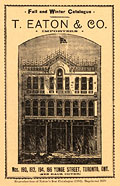 |
|
| |
 Eaton's
Fall/Winter Catalogue, 1884, cover (reproduction). Eaton's
Fall/Winter Catalogue, 1884, cover (reproduction).
|
|
| |
|
|
|
Timothy Eaton's first catalogue, published in 1884, was a 32-page
booklet
distributed to out-of-town visitors at the exhibition in Toronto. Eaton
expressed
his vision for the catalogue in 1887: "This catalogue is destined to
go
wherever the maple leaf grows, throughout the vast Dominion. We have the
facilities
for filling mail orders satisfactorily, no matter how far the letter has
to come
and the goods have to go."
|
Early Growth
From the 1890s, Eaton's factories in Central Canada and Winnipeg
manufactured
a range of goods: men's and women's clothing, jewellery,
furniture,
upholstered goods, window shades, harness, horse collars, suitcases and
leather
trunks.
Eaton's mail-order business grew quickly. Mail-order stock was
separated
from that of the store in its own building in 1903. Eaton's produced
a
number of giveaways, such as fans, fly swatters, shoehorns, celluloid
bookmarks,
and match safes, which promoted the image of the company.
 Fans,
bookmark, and match safe used as promotional giveaways by Eaton's. Fans,
bookmark, and match safe used as promotional giveaways by Eaton's.
|
|
|
|
|
|
Eaton's published a number of specialized catalogues for the
Western
market such as the Klondike Catalogue (1898) and the Settlers'
Catalogue
(1903). The Winnipeg edition was introduced in 1905. The growth rate in
Winnipeg
at the time was faster than in Toronto, and Winnipeg became the
distribution
centre for Western mail-order business.
|
|
|
 Examples
of Eaton's specialized catalogues, including: Christmas, 1905, Groceries,
1927, Seeds 1928, and Wallpapers, 1941. Examples
of Eaton's specialized catalogues, including: Christmas, 1905, Groceries,
1927, Seeds 1928, and Wallpapers, 1941.
|
|
|
|
|
After the death of founder Timothy Eaton in 1907, John C. Eaton became
president.
His wife was also a key figure in establishing the image of the
Eaton's
business and family. Eaton introduced the guarantee that goods must be
satisfactory
or money would be refunded, and the policy that postage be paid both ways.
Sales
were conducted on a cash-only basis. In 1909, the mail-order department
was organized
into separate departments and began to purchase its own stock.
|
Eaton's Brands
| |
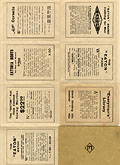 |
|
| |
 Eaton's
brand name ads on the reverse side of a map of the CNE. Eaton's
brand name ads on the reverse side of a map of the CNE.
|
|
| |
|
|
|
The practice of using trademarks and brand names grew after 1910 and
the number
of Eaton's trademarks that were introduced increased rapidly. Eaton
brands
included Eaton, Eatonia, Acme, Cravinette, Edgerite, Imperial, Foundation,
Multiplex,
Braemore, Lady Fair Birkdale, Renown, etc. Some of these products were
produced
by Eaton's or by subsidiary firms; others were produced under
license.
| |
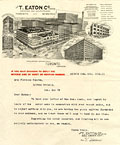 |
|
| |
 Eaton's
buildings on its letterhead, 1916. Eaton's
buildings on its letterhead, 1916.
|
|
| |
|
|
|
Eaton's Winnipeg sold $11 million worth of goods in 1911,
including
houses and barns. Eaton's introduced the Product Research Bureau to
study
goods being offered through the catalogues and to compare them with those
sold
by other companies. Also in 1916, a new eight-storey building behind the
Winnipeg
store provided 2 hectares [five acres] of floor space for the mail-order
department.
|
Expansion in the West and East
| |
 |
|
| |
 Two-page
ad from the Christmas Globe, 1908. Two-page
ad from the Christmas Globe, 1908.
|
|
| |
|
|
|
In Saskatchewan, Eaton's went head-to-head with Simpson's.
Simpson's
built an eight-storey warehouse in Regina in 1916. Eaton's
established
distribution centres in Saskatoon and Regina to provide faster delivery of
heavy
goods to customers in Saskatchewan, Alberta, and British Columbia. There
was
a strong relationship between the stores and the mail-order catalogues.
New stores,
with mail-order salesrooms, opened throughout the region. Eaton's
was slow
to open stores in British Columbia because of the strength of the
competition,
Woodward's.
| |
 |
|
An advertisement for Eaton's
Farm Buildings and Equipment Catalogue that complied with the Soldiers'
Land Settlement Scheme. Eaton's (Winnipeg) Fall/Winter Catalogue, 1919-20,
p. 420.
|
 |
|
In response to the Canadian government's Soldiers' Land
Settlement
Scheme after the First World War, Eaton's produced a booklet for
soldiers
planning to farm in the West, containing "the full requirements of a
soldier."
The economy on the Prairies boomed and a second nine-storey building was
built
in Winnipeg in 1921.
| |
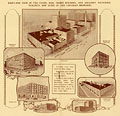 |
|
| |
 Facts
of interest about Eaton's, 1921. Facts
of interest about Eaton's, 1921.
|
|
| |
|
|
|
| |
 |
|
| |
 A
piece of fruitcake to celebrate the first birthday of Eaton's Moncton
mail order. A
piece of fruitcake to celebrate the first birthday of Eaton's Moncton
mail order.
|
|
| |
|
|
|
Eaton's Atlantic headquarters was built in Moncton in 1920, the
same
year that Eaton's mail-order business peaked at $60 million. The
catalogues
remained important in the West throughout the settlement period, although
the
value of individual orders dropped during the Depression. In the 1930s,
Eaton's
introduced a monthly payment plan for large ticket items. With growing
urbanization
in the post-war period, the catalogues decreased in importance.
|
Competition with Simpson's
| |
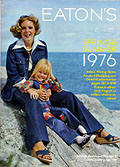 |
|
| |
 Eaton's
Spring/Summer Catalogue, 1976, cover. Eaton's
Spring/Summer Catalogue, 1976, cover.
|
|
| |
|
|
|
Eaton's was forced to re-evaluate its practices after
Simpson's,
its largest competitor, merged with Sears of the United States in 1953.
Each
district had done its own buying until, as part of a structural
reorganization
of the company, buying for both the stores and the catalogue was
centralized
in a Company Merchandise Office. Eaton's began to abandon
manufacturing
in the mid-1960s. In the 1960s, the catalogue was profitable only in the
West
and in Atlantic Canada, and by the early 1970s, the Eaton's
catalogue was
losing $17 million a year. In 1976, it ceased operations.
In 1900, three-quarters of Canadians lived on farms; by the 1970s, the
population
had shifted and three-quarters of Canadians lived in cities. Changing
demographics
is only one explanation for the closure of the mail-order department;
Sears's
mail order thrived after the Eaton's closure, tripling its sales.
Management
problems within Eaton's eventually led to the bankruptcy of the
stores
as well as the end of the catalogues.
|
| |
|
|